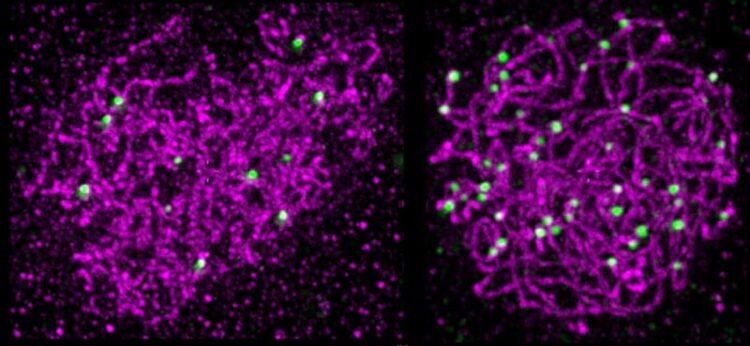Evidence for new theory of genetic recombination

Joint strategy results in massive increase in genetic recombination. Crossovers, marked by green dots on the purple chromosomes, are massively increased upon overexpression of HEI10 and mutation of ZYP1 (cell on right) compared to a normal cell (left).
Credit: R. Mercier
New findings suggest an explanation for how chromosome recombination is regulated during sexual reproduction.
In most higher organisms, including humans, every cell carries two versions of each gene, which are referred to as alleles. Each parent passes on one allele to each offspring. As they are linked together on chromosomes, adjacent genes are usually inherited together. However, this is not always the case. Why?
The answer is recombination, a process that shuffles the allele content between homologous chromosomes during cell division. Mechanistically, recombination is achieved by crossovers, where homologous chromosomes contact each other, resulting in the exchange of genetic material.
Crossovers have long fascinated scientists and especially plant breeders because manipulating the crossover process offers the potential of increasing genetic diversity and of assembling desired combinations of alleles that boost crop productivity. Crossovers are subject to a “Goldilocks principle”; at least one is required per chromosome pair for successful sexual reproduction; indeed, a lack of crossovers is a major cause of human trisomy such as in the case of Down’s Syndrome. Crossover numbers are also tightly regulated and generally do not exceed three. This limit on crossover number, and therefore, recombination, is achieved by crossover interference, a phenomenon through which crossovers inhibit additional crossovers in their vicinity. However, how this interference works has remained a mystery since it was first described some 120 years ago.
New model of crossover interferenc
Now, a team led by Raphael Mercier at the Max Planck Institute for Plant Breeding Research in Cologne, Germany, have found convincing evidence in support of a recently proposed model of crossover interference. Mercier and his team, together with collaborators, in work spearheaded by Stéphanie Durand, Qichao Lian, and Juli Jing, achieved these insights by manipulating the expression of proteins known to be involved in either promoting crossovers or in connecting chromosomes together in the model plant Arabidopsis thaliana, a species which Mercier and his colleagues use to gain fundamental insights into the mechanisms of heredity. Boosting expression of the pro-crossover protein HEI10 resulted in a significant increase in crossovers, as did disrupting the expression of the protein ZYP1, a constituent of the synaptonemal complex, a protein structure that forms between homologous chromosomes.
When the scientists combined the two interventions, they were surprised to observe a massive increase in crossovers, showing that HE10 dosage and ZYP1 jointly control CO patterning. Importantly, massively increasing crossovers in this way barely affected cell division.
The considerable increase in crossovers upon increasing HEI10 levels chimes well with an emerging model for how crossover number is regulated. This model, formulated by David Zwicker and his team at the Max Planck Institute for Dynamics and Self-Organization in Göttingen, Germany, is based on diffusion of the HEI10 protein along the synaptonemal complex and a coarsening process leading to well-spaced HEI10 foci that promote crossovers. In the model, HEI10 initially forms multiple small foci and is progressively consolidated into a small number of large foci that co-localize with sites of crossovers. In this simple model, increasing the levels of HEI10 will result in more foci and therefore more crossovers; thus, the formation of droplets along an axis appears to be the determinant of crossover sites.
Mercier is excited by the team’s findings but is also already looking ahead: “These results are an exciting insight into a process that has baffled scientists for over a hundred years. Next, we want to better understand what controls the dynamics of the HEI10 droplets and how they promote crossovers. If we can get a better handle on how the process works, this may allow us selectively boost recombination during plant breeding, enabling the assembly of combinations of beneficial alleles that have remained out of reach.”
Journal: Nature Communications
DOI: 10.1038/s41467-022-33472-w
Method of Research: Experimental study
Article Title: Joint control of meiotic crossover patterning by the synaptonemal complex and HEI10 dosage
Article Publication Date: 12-Oct-2022
Media Contact
All latest news from the category: Life Sciences and Chemistry
Articles and reports from the Life Sciences and chemistry area deal with applied and basic research into modern biology, chemistry and human medicine.
Valuable information can be found on a range of life sciences fields including bacteriology, biochemistry, bionics, bioinformatics, biophysics, biotechnology, genetics, geobotany, human biology, marine biology, microbiology, molecular biology, cellular biology, zoology, bioinorganic chemistry, microchemistry and environmental chemistry.
Newest articles

Innovative 3D printed scaffolds offer new hope for bone healing
Researchers at the Institute for Bioengineering of Catalonia have developed novel 3D printed PLA-CaP scaffolds that promote blood vessel formation, ensuring better healing and regeneration of bone tissue. Bone is…

The surprising role of gut infection in Alzheimer’s disease
ASU- and Banner Alzheimer’s Institute-led study implicates link between a common virus and the disease, which travels from the gut to the brain and may be a target for antiviral…

Molecular gardening: New enzymes discovered for protein modification pruning
How deubiquitinases USP53 and USP54 cleave long polyubiquitin chains and how the former is linked to liver disease in children. Deubiquitinases (DUBs) are enzymes used by cells to trim protein…



